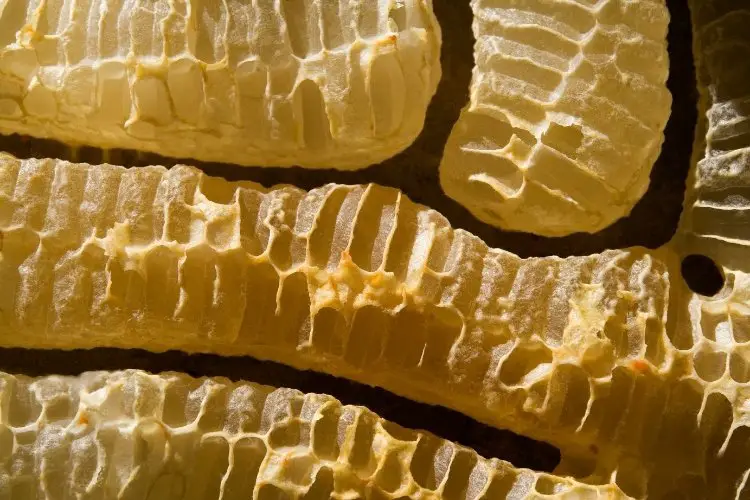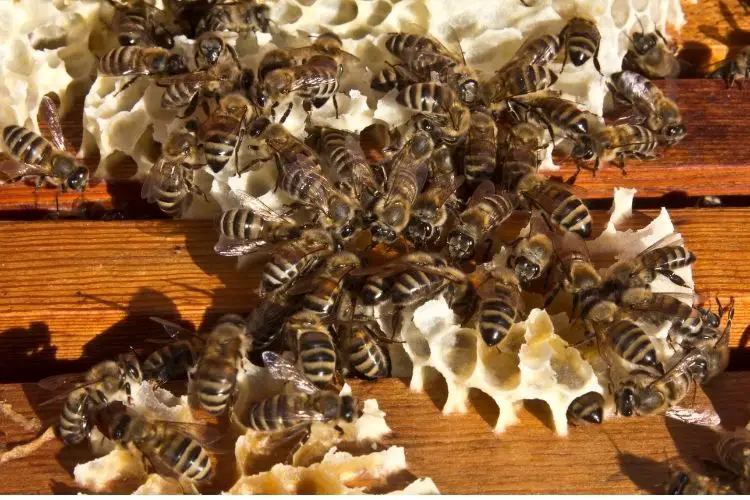Bee space refers to the small gaps found within a beehive that allow bees to move around. Typically, bees will leave these spaces free of wax and propolis unless the gaps are too big or small.
In a natural hive, bees leave spaces wide enough between sheets of the comb so they can move easily between them.
However, in a beehive, beekeepers need to intentionally leave gaps between beehive components that are between 1/4 and 3/8 of an inch (6 and 9 mm) wide to allow bees to move.
When these spaces are too big or too small, bees will place comb or propolis in the gaps. Unfortunately, this makes it hard for beekeepers to perform inspections without damaging the structures or hurting bees. Generally, bees will fill gaps that are less than 1/4 of an inch with propolis and gaps greater than 3/8 of an inch with wax.

History Of Bee Space
Reverend Lorenzo Langstroth was an American clergyman and apiarist (beekeeper) who designed the Langstroth hive – the most popular style of beehive used today.
He is often credited with the discovery of bee space. However, this concept was already in use in European hives.
However, Lorenzo Langstroth included the use of bee space in his top opening hive, which changed the beekeeping industry.
Langstroth wanted to be able to remove the cover of his beehives easily, without damaging the hive components or comb. Usually, the cover was cemented to the frames with propolis.
In the Summer of 1851, Langstroth found that by leaving a space approximately the width of a bee between the top of the frames that held the honeycomb and the cover, he could readily remove the cover without damaging anything.
Langstroth later used this discovery to make standardized frames that could be easily removed.
Mind The Gap: Why Bee Space Is Important
Correct bee space is important within a hive because it allows the bees to move around between frames. It also means you can examine your hive without damaging the comb on the frames or other components of the hive.
Too much bee space allows the bees to build comb between the frames, hive body, and cover. You won’t be able to inspect your hive because doing so will break the comb and most likely injure or kill some of the bees.
You’ll also risk damaging the frames or the cover when trying to put these parts apart. Additionally, once you get your hive open and inspect it, you are more likely to find excess comb to remove and clean up. As a result, your hive inspection will take you longer.
Too little bee space also has several implications. First, the bees will build comb in unwanted places to give themselves more room for food storage.

More importantly, not enough bee space means the bees won’t have enough room to move around the hive and between the frames. Therefore, their ability to store pollen and honey is limited.
The lack of bee space also restricts the movement of the queen. Therefore, she will be unable to move from cell to cell to lay eggs, and the colony’s growth will be compromised. This could result in swarming because the colony will think they don’t have enough room to grow, so they’ll leave to find a new home.
Types Of Bee Space
When assembling a beehive, there are two types of bee space you should keep in mind. They are top bee space and bottom bee space.
Top Bee Space
If the frames are leveled with the bottom of the box, and the bee space is at the top, the term used is Top Bee Space.
Bottom Bee Space
If the frames are leveled with the top of the box and the bee space is at the bottom, this is called Bottom Bee Space.
Top vs. Bottom Bee Space: Which Is Better?
Both top bee space and bottom bee space have pros and cons. The hives I own, have top bee space. However, when the covers are replaced, bee space is enlarged, and sometimes in spring, comb is built in the gap. This can make it difficult to remove the lid unless I am vigilant.
Below I’ve outlined my thoughts on the possible pros and cons of top bee space and bottom bee space. One thing is certain, though, you have to have one or the other in all your hives. If you have a mixture of both, you will have either no space between hive boxes or twice as much bee space than necessary. Then you will end up with the frames propolized together or a large gap filled with burr comb.
Top Bee Space – Pros and cons
| Pros | Cons |
|---|---|
| It’s easier to put a queen excluder on without crushing too many bees. | Bees may build comb to fill the space between the top of the frames and the lid. |
| Allows warm air to rise and escape through the vented lid. | |
| The frames in the lower box are less likely to stick to the upper box. |
Bottom Bee Space – pros and cons
| Pros | Cons |
|---|---|
| Frames stored in the box won’t touch the ground and therefore are kept cleaner. | The frames in the lower box are more likely to stick to the upper box. |
| Less possibility of insect pests reaching the frames. | The bees may build extra comb at the bottom of the hive. |
| Bees will build swarm cells in the bee space below the frames, making them easier to locate when you do an inspection. |
Again, I think both types are fine. It mostly depends on your preference and which one is available to you as sellers in some countries only offer one of the two. Whatever you choose, make sure all you components match that configuration!
How To Make Sure Your Hives Have The Right Bee Space
You need to make sure all your hives have the right bee space. Before buying a hive, it’s good to get some advice from an experienced beekeeper in your area to discover whether top or bottom bee space works best. Ask for the name of a vendor they could recommend.
I’d suggest you visit the vendor to purchase your hives and not buy online. Ask them if you can examine their hives to see if they support top or bottom bee space.If you are using a Langstroth hive, all the components are standardized to conform to bee space, with spaces no wider than 3/8 inch. This means that after an inspection in a Langstroth hive, you can maintain bee space by ensuring you push all the frames back together carefully.
However, if you aren’t so careful and some of the spaces are wider than 3/8” inch, then you may find comb being built in these spaces the next time you do an inspection.
Conclusion
Bee space is the space left by the bees that enables them to move and work within the hive. This space is between 1/4 and 3/8 of an inch.
As a beekeeper, you need to maintain the correct bee space within your hive to ensure your bees can comfortably live and work there. Too much or too little bee space could present problems when you inspect your hives.
